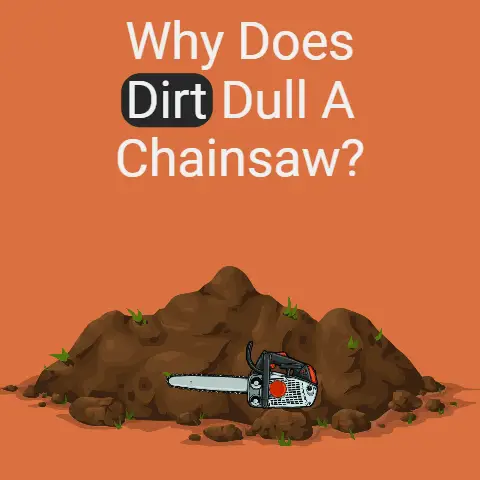Can’t Get My Stihl Chainsaw to Start (5 Fixes to Try)
Can’t Get My Stihl Chainsaw to Start (5 Fixes to Try)
Life’s hectic, isn’t it?
Between work, family, and everything else, finding time for those outdoor tasks can be a real challenge.
So when that moment finally arrives, and your Stihl chainsaw decides it’s on strike, it’s enough to make anyone want to scream.
But don’t worry, I’ve been there too, and I’ve got some tricks up my sleeve that might just help you out.
My Chainsaw Story
A few summers ago, I was all set for a weekend of clearing out some old trees from my backyard.
With a fresh pot of coffee and a playlist ready to go, I pulled the starter cord on my trusty Stihl chainsaw.
And… nothing.
Not even a sputter.
Sound familiar?
I tried everything I could think of, but the chainsaw stubbornly refused to start.
After a lot of trial and error, I finally got it running again.
It taught me a few things about patience and perseverance—and gave me some knowledge I’m eager to share with you today.
Prerequisites and Required Materials
Before we dive into the fixes, let’s make sure you’ve got everything you need:
- Stihl Chainsaw Manual: Your go-to guide for specifications and safety warnings.
- Fresh Fuel Mixture: Stihl recommends a 50:1 ratio of fuel to oil.
- Spark Plug Wrench: For easy removal and installation.
- Screwdriver: For carburetor adjustments and cover removals.
- Clean Cloth: To wipe down components.
- Air Filter Cleaner or Replacement: For maintaining airflow.
Safety First!
Chainsaws are powerful tools, so let’s keep safety at the forefront:
- Turn Off the Chainsaw: Ensure it’s off before attempting any maintenance.
- Wear Gloves and Eye Protection: Protect those fingers and eyes!
- Keep your work area Clear of Hazards: Trip hazards and obstacles can cause accidents.
Fix #1: Check the Fuel
One of the most common reasons a chainsaw won’t start is fuel-related.
Here’s how you can tackle this issue:
Step-by-Step Fuel Check
- Inspect the Fuel Tank: Open the cap and take a whiff.
If it smells stale, it probably is. - Empty Old Fuel: Carefully pour out any old fuel into a suitable container for disposal.
- Refill with Fresh Fuel: Use a fresh mixture, ideally prepared within the past month.
Tip: Always use high-quality gasoline and Stihl’s recommended oil to ensure smooth operation.
Why Fresh Fuel Matters
Fuel degrades over time, especially ethanol-blended fuels which can absorb moisture and lead to phase separation.
This can cause your engine to sputter or fail to start altogether.
Personal Anecdote
Once, I left fuel in my chainsaw over winter without adding a stabilizer.
Come springtime, it wouldn’t start for anything!
Since then, I’ve made it a habit to empty the tank if I’m not using it for more than a month.
Fix #2: Inspect the Spark Plug
The spark plug is essential for ignition, and any issues here can prevent your saw from starting.
Step-by-Step Spark Plug Inspection
- Remove the Spark Plug: Use your wrench to carefully unscrew it.
- Examine the Condition: Look for carbon deposits or physical damage.
- Clean or Replace the Plug: Clean with a wire brush if dirty; replace if damaged.
Warning: Handle spark plugs carefully to avoid damaging the delicate insulator.
Understanding Spark Plug Issues
A faulty spark plug can result in weak or inconsistent sparks.
This can lead to rough idling or difficulty starting.
Common Missteps
Many assume that a spark plug is fine if it looks clean from the outside.
However, the insulator inside might still be cracked, leading to performance issues.
Fix #3: Clean or Replace the Air Filter
A dirty air filter can suffocate your engine by restricting airflow. Let’s fix that:
Step-by-Step Air Filter Maintenance
- Access the Air Filter: Remove the cover as per your manual’s instructions.
- Inspect the Filter: Check for dirt, oil, or debris buildup.
- Clean or Replace: If it’s clogged with debris, use compressed air to clean it or replace it if necessary.
Tip: Always have a spare filter on hand—it’s a quick fix that can save you time.
Why Clean Air Matters
Engines require a precise mix of air and fuel; too little air due to a clogged filter can cause rich running conditions leading to poor performance or starting issues.
Personal Experience
I once cleaned my air filter only after my chainsaw refused to start during an urgent yard cleanup.
After cleaning it out, the saw roared back to life like new!
Fix #4: Adjust the Carburetor
If your engine isn’t getting the right mix of fuel and air, adjusting the carburetor might be necessary.
Step-by-Step Carburetor Adjustment
- Locate Adjustment Screws: Typically marked L (low speed) and H (high speed).
- Consult Your Manual: Each model has specific settings.
- Make Adjustments: Turn screws slightly while running to achieve smooth operation.
Warning: Small adjustments make big differences; proceed with caution.
The Role of Carburetors
Carburetors mix air and fuel in precise ratios for combustion efficiency.
Incorrect settings can lead to poor performance or starting issues.
Expert Tip
If you’re not comfortable adjusting the carburetor yourself, consult with a professional—incorrect settings can damage your engine over time.
Fix #5: Examine the Recoil Starter
When all else fails, checking the recoil starter mechanism could be key:
Step-by-Step Recoil Starter Check
- Remove Starter Cover: Use a screwdriver to access internal components.
- Inspect Spring and Rope: Look for signs of wear or damage.
- Replace as Needed: A worn spring or frayed rope should be replaced promptly.
Tip: Regular checks can prevent unexpected breakdowns during use.
Understanding Recoil Starter Issues
If the recoil starter isn’t functioning properly, it won’t engage the engine’s crankshaft effectively.
Personal Insight
I’ve had recoil springs snap mid-job—always frustrating!
Keeping spares around has saved me from unnecessary downtime more than once.
Common Questions & Concerns
Why does my chainsaw start but then stall?
This could be due to an incorrect fuel mix, carburetor misalignment, or even a clogged air filter causing insufficient airflow.
How often should I replace my spark plug?
Typically after 100 hours of use or once per season—whichever comes first.
Troubleshooting Tips
- Always start with simple solutions before diving into complex fixes.
- Keep a logbook detailing what works and what doesn’t for future reference.
- Don’t overlook preventative maintenance; it can save time and money in the long run.
Important Reminders & Next Steps
Once your chainsaw is up and running again:
- Perform regular maintenance checks after every few uses.
- Store your chainsaw properly by draining fuel if not used regularly.
- Consider seasonal servicing from professionals to maintain peak performance.
Extended FAQ Section
Q: What should I do if my chainsaw still won’t start after these fixes?
A: It might be time to consult a professional mechanic or reach out directly to Stihl customer support for further assistance.
Q: How do I know if my carburetor needs cleaning?
A: Symptoms include rough idling, difficulty starting, or noticeable fuel leaks around the carburetor area.
Q: Are there any special considerations for winter storage?
A: Yes!
Drain all fuel before storing over winter months and consider using a stabilizer in remaining fuel tanks for short-term storage.
Remember that persistence pays off when dealing with mechanical hiccups—hopefully these insights help get you back on track quickly!
Happy sawing!






